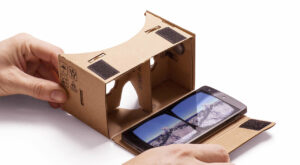 Averaging less than $15 for a pretty decent set, Google Cardboard is leading this new wave of virtual reality that’s going to offer some pretty substantial marketing opportunities, even in business-to-business.
Averaging less than $15 for a pretty decent set, Google Cardboard is leading this new wave of virtual reality that’s going to offer some pretty substantial marketing opportunities, even in business-to-business.
And they aren’t only made out of cardboard. Foam, plastic and metal versions are available, too, if you want a more durable, dirt-resistant model (hey, cardboard is still cardboard).
You won’t get bored with this cardboard
Apps already exist for things as varied as a roller coaster simulator (could use some work) up to fighting off the zombie apocalypse (very intricate). Think about how you could showcase a new product in a 3D rendering or through an interactive demo, all held right in your clients’ hands.
There’s still some things to consider, like the mandatory Apple or Android content review process as well as which platform to develop in (one only or both), but the adoption is happening at a much quicker rate than Google Glass.
The cost to create a custom app is still fairly cumbersome, but the lower cost of entry for the actual viewers means you will have a much larger audience ready to view your app, versus Google Glass, where only the chosen few had access to the technology. For a game changing product launch, you might want to consider Google Cardboard.
And as with any tech innovation, app development costs will continue to decline as the technology matures.
Everyone’s on board with the cardboard!
With organizations like The New England Patriots handing out ten thousand units to fans at a recent game, and pillars like the New York Times developing an app and selling subscriptions, people are going to be looking for ways to use these things. And we missed the Star Wars-branded Cardboard giveaway at Verizon stores by a day!! (it was a sad day at the farmhouse…)
But it didn’t deter us, in fact it inspired us to develop a list of considerations for bringing Google Cardboard into your marketing program:
- Format: There are universal viewers that fit a wide range of smartphones as well as ones designed for certain models specifically
- Platform: More Android apps than Apple currently; will you develop in both?
- Timing: App content approval required from Android (10-12 hours) or Apple (10-13 days!)
- Content: This is 3D people! What can you showcase here that you haven’t been able to get across in a flat datasheet before?
- Longevity: Look to use the app for different industry segments or marcom initiatives—tradeshows, sales, PR—to maximize development costs
- Cost: With app development still on the pricey side, we recommend saving this for major initiatives…for now
So, we have to admit, we’re a bit enamored by Google Cardboard, much more so than when QR codes were all the rage. With its low cost of entry for viewers and very impressive abilities to showcase advanced design concepts in 3D, we are excited to see how this one develops.
Check out Wired’s nice overview for more technical info: http://www.wired.com/2015/12/google-cardboard-camera-app/
